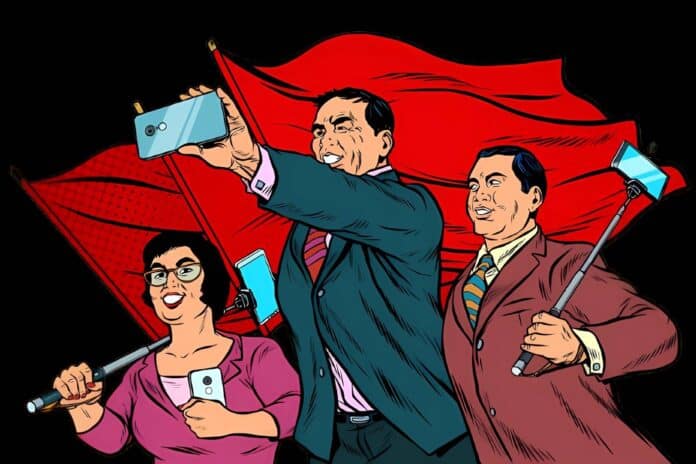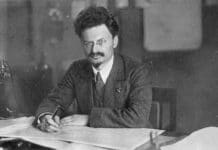This is an edited version of a speech given by Peter Chan of chinaworker.info to the ISA’s Virtual Marxist University in July 2020, which is now published for the first time. Marxists have continuously discussed and debated what kind of state the CCP dictatorship is, how was capitalism restored in China, and what are the specific features of China’s form of capitalism. Given the decisive weight of China in the global economy and its sharpening conflict with the US, these questions have an important bearing on perspectives for the inter-imperialist struggle and the class struggle.
We would describe the character of today’s China as a form of state capitalism. It is a special – very advanced – form of state capitalism. It replicates some of the features of other ‘state capitalist’ economic models such as Singapore, South Korea, and in the past also Japan. But to be clear, China is capitalist. The designation ‘state capitalism’ describes the particular form, while the substance, the type of state and economic system, is capitalist. This is not to be confused with various left and sectarian theories in the past, which believed Stalinism and the USSR were ‘state capitalist’.
Mao Zedong also said the USSR was state capitalist – it went from “real socialism” under Stalin to “state capitalism” under his successors, but how this happened was never explained. Various state capitalist theories argued that the Stalinist bureaucracy was a giant single capitalist enterprize exploiting the working class. They rejected Trotsky’s analysis that Stalinism, because of its state-owned and planned economic foundations, was a workers’ state – a very deformed one. This wrong diagnosis would lead to serious political mistakes. The SWP, which believed the Stalinist states in Russia and Eastern Europe were state capitalist, did not clearly recognise the counter-revolution in the 1990s. They called it a “sideways step” – from state to market capitalism. In reality, the capitalist counter-revolution, including in China following the 1989 Tiananmen massacre, and the break-up of the bureaucratically-run planned economies, represented a very serious defeat for the workers’ movement globally.
Deformed workers’ state
To understand the process of how capitalism was restored in China, first we must go back in time to 1949. The Chinese Revolution in 1949, as we all know, was a great revolution, on a vast scale, which changed the course of world history. But it was a deformed workers’ state from the very beginning, modelled after the Stalinist dictatorship in the USSR. Actually, we can say it was a deformed workers’ state “in the process of formation” – the direction was clear, but the social forces in China meant the processes were weaker, less developed than in Russia. The class forces and program of the Chinese revolution were not a Marxist workers’ revolution, but a nationalist peasant-based revolution. Therefore the Chinese Revolution is very different from the Russian Revolution. The working class, while supportive, was a bystander in the revolution and played no active part.
Unlike in Russia, there was never a period when the working class in China had any control over the state and economy. This is a crucial difference, with important consequences for the consciousness of the masses and especially the working class. In the Mao era, a bureaucratic dictatorship exercised power over society and the economy. The regime of Mao enjoyed mass support especially in its first years because of major social gains: Land reform, the end of foreign colonialism, exemplary healthcare reforms, educational improvements and cheap housing. These social reforms were only possible because capitalism was abolished and replaced by state ownership and planning of the economy, but on the distorted bureaucratic model copied from Stalin’s USSR.
But in 1949 and until at least 1953, the CCP did not want to take this road. At first, Mao envisaged 100 years of capitalism before “socialism” would be possible. The country saw great achievements during the Maoist period. From 1952 to 1978, China’s industrial output grew by 11.3% per year on average. Today, the Chinese regime and global capitalism hide this history. They say the rapid GDP growth only began with the capitalist ‘reform and opening’ in the 1980s. From 1952 to 1978, the average lifespan of Chinese people increased from 35 to 65, and the illiteracy rate dropped from 80% in 1949 to 33% in 1980.
Not a ruling class
Trotsky explained in his analysis of Stalinism in the 1930s, that the ruling bureaucracy was a transitional and unstable social formation. It lacked the stable economic foundations and durability of a ruling class – based on property ownership.
In conditions of even greater backwardness and isolation in China in the 1950s and 60s (especially after the split with the USSR) the CCP bureaucracy was even more unstable than Russian Stalinism. This explains the endless turmoil that characterised the Mao years, most graphically seen in the Cultural Revolution (1966-76), which contained features of civil war.
In a capitalist economy the position of the capitalists is a necessary one. But in a planned economy the role of the Maoist-Stalinist bureaucracy was completely parasitic – a “cancerous growth” as Trotsky said. By the 1970s, the Chinese bureaucracy became not only a relative, but an absolute deadweight on economic development. The Chinese Revolution therefore, in the absence of a clear working class alternative and movement, was an unfinished and unconsolidated revolution. The only way to defend the social gains of the revolution was a new, political revolution by the workers to break the power of the Stalinist bureaucracy and establish real socialism.
After Mao’s death in 1976, the CCP regime was in a massive crisis. GDP growth was negative 1.5%, and society was in chaos. The state-owned economy was performing erratically. The CCP bureaucracy, shaken by the tumultuous events of Mao’s final years, yearned for security and stability – guarantees for its positions and privileges, which could only be realised by a change of property relations, in other words, by abandoning the state-owned planned economy in favour of capitalism. Over a million people gathered in Tiananmen Square on April 5, 1976, which became known as the “Tiananmen Square incident” (not to be confused with the 1989 movement which also took place in Tiananmen Square).
There was mass anger against the regime and especially its most Maoist figures. The CCP feared they would be overthrown by the masses – in 1976. Deng Xiaoping’s rise to power in the late 1970s reflected the fact that the bureaucracy and the system of Chinese Stalinism had arrived at a complete impasse. Deng’s programme reflected a search for an alternative based on various experiments and ‘reforms’, which included capitalist measures.
“Crossing the river …”
The turn to capitalism did not flow from a worked out master plan, the CCP ruling group knew they had to change, but were unclear where and how to change. Deng used an approach he famously called “crossing the river by feeling the stones.” Initially, even before Mao’s death, the CCP looked towards the “liberal” market reform experiments of Stalinist Hungary and Yugoslavia. Yugoslavia had already gone to the IMF for loans in the late 1970s, a sign of deep trouble. The CCP had always smeared Yugoslavia as “revisionist” but now stopped.
Already in the late 1970s, the CCP and Deng began to look even more to East Asia for inspiration. The powerful growth of state capitalist ‘tiger’ economies in East Asia including South Korea, Singapore and Taiwan became the model of CCP reforms. A big attraction for the CCP was that these economies were also one-party dictatorships, but based on capitalism. Deng visited these countries. He said, “the more we see, the more we realise how backward we are”.
The CCP leaders were not Marxists. They were nationalists with a few fragments of Marxism thrown in. For Chinese nationalists the sight of “small” nations and former Chinese tribute states now achieving much faster modernization than China was disturbing and shocking. Therefore, ideologically, it was not a huge leap for the CCP leaders to abandon the planned economy in favour of the East Asian authoritarian state capitalist model.
As Deng famously said, “It doesn’t matter whether a cat is black or white, as long as it catches mice.” China’s initial capitalist reforms were modest, but gathered pace throughout the 1980s and led to growing class differentiation. The development of a new bourgeois class and bourgeois economic relations acquired a powerful logic of its own. A conscious pro-capitalist counter-revolutionary stratum crystallised within the top levels of the CCP. The growing confidence of this nascent bourgeois wing of the CCP bureaucracy was reflected in Deng’s pronouncement that his market reforms constituted “the second revolution”.
The CCP introduced capitalist reforms, in most cases quite gradually, testing them in one region before allowing them more widely. The Deng regime first opened up to foreign investments (which was made possible with the establishment of diplomatic ties with the USA in 1979). They allowed private companies to operate in the market, initially with very strict controls. At the same time SOEs (state-owned enterprises) were transformed into profit-driven structures. Later they were privatised or part-privatised. The biggest SOEs are now on the stock market, where they dominate, but that came later.
Smashing the “iron rice bowl”
However, the reforms were not without resistance from below, especially in the urban areas. In the first ten years of so-called reform and opening, despite it not being total privatisation, the market reforms had already brought huge shocks to the whole society. The working class lost their permanent job protection, part of the “iron rice bowl” which included pensions and healthcare services. Schools, kindergartens, housing, and even electricity, were also largely organized by the SOE where you worked. The CCP used neo-liberal and “Thatcherite” language to blame the “iron rice bowl” for making workers lazy and “holding back the economy”. Deng said the iron rice bowl needed to be “smashed”. Still today, most capitalists in China regard welfare systems in Europe as a reason these societies are in crisis with poor GDP growth.
In February 1985, the CCP lifted the price controls of commodities. They shifted to a two-price system: a state-set price, for centrally rationed supplies, and a higher free-market price. CCP bureaucrats used their power and privileges to make money through speculating between state prices and market prices. Consumer goods became much more unaffordable, and the inflation rate spiked to over 31% in 1989. This was the worst since 1949 and was a trigger for the Tiananmen Movement in 1989. One of the core demands of the 1989 movement was against the speculation in the dual-track economy.
However, pro-capitalist reforms faced less resistance in rural China, as the failed people’s commune system had shaken the peasantry’s confidence towards planning. Under the newly adopted “household responsibility system”, the state allowed peasants to operate as private farms to directly buy and sell their commodities. The people’s communes were dismantled, which also gave rise to the new migrant workers, forming a massive reserve army of labour (the biggest in world history).
This allowed the state to break the resistance of the urban working class. The local CCP bureaucrats, of course, were able to make use of their position to accumulate wealth and private capital through grabbing the best land and rural development projects. The breakdown of the old centrally planned system had already gone a long way by the time of the 1989 mass movement. At the same time, Deng’s reform program was meeting bigger and bigger problems and mass discontent.
This was the background to the explosion of struggle in April to June 1989, the seven weeks that shook the world. This movement is something that has been widely misunderstood both in right-wing and left-wing political circles. It was a movement in the direction of political revolution – incipient and not sufficiently conscious – but huge. There were mass demonstrations in over 300 cities. In some there were regional ‘Tiananmens’ with the city centres occupied for weeks. This movement almost overthrew Deng and the CCP dictatorship. But without a clear program and a revolutionary workers’ party, the Chinese regime crushed this nascent political revolution.
Analysis and debates in the CWI
At the time, the CWI [the forerunner of ISA] misunderstood this process. It regarded the Tiananmen crackdown as a Stalinist counter-revolution. But actually this was wrong. In general, the CWI’s analysis and of course the program the comrades put forward internationally was correct. But without any forces in China, it was not possible to fully understand what was going on.
Trotsky had explained that under Stalinism the only force that could save the planned economy and prevent capitalist restoration was the working class. For a whole period, in the 1980s, the CWI underestimated the pressures towards capitalist restoration in the Stalinist states. This was corrected later, based on our analysis of what happened in Eastern Europe and Russia in the early 1990s. This correction was a key reason for the split with what has since become the IMT [now renamed to RCI].
In China, rather than the reconsolidation of the Maoist-Stalinist regime and state, the crackdown of 1989 represented a heavy defeat of the workers’ political revolution and an enormous fast-forwarding of the process of capitalist restoration. Deng and the CCP “elders” installed a pro-capitalist leadership after the Beijing massacre. Jiang Zemin and Zhu Rongji, the leaders of the most pro-capitalist city, Shanghai, were brought to Beijing to take over. Li Peng, a so-called hardliner, became the Prime Minister, but the overall balance of the post-1989 government was more pro-capitalist than before.
The CCP hardliners and reformers reached a consensus, a synthesis: continued dictatorial rule with a flat no to any political reforms or democratic rights, side by side with accelerated measures to develop a capitalist economy. At the same time, the world situation also pushed the CCP to adopt more audacious capitalist policies. The collapse of the Stalinist regimes in the USSR and Eastern Europe had a decisive impact on processes in China. This also accelerated the process of capitalist globalisation and neoliberalism on a world scale. The Shanghai and Shenzhen Stock Exchanges were founded in 1990. Today the Chinese stock market is the biggest outside the US.
After the historic Southern Tour by Deng in 1992, more SOEs were privatised and were listed on stock markets. This allowed more CCP officials to transform themselves from being bureaucrats to capitalists with private property and capital. At the same time, there were massive layoffs in the state sector, the total unemployment rate in 1996 reached 21.4%, according to a researcher at the Chinese Academy of Social Sciences. Capitalists were officially allowed to join the Communist Party during the 1990s leadership of Jiang Zemin.
The constitutional amendment introduced by Jiang Zemin in 2002, known as “The Theory of Three Represents,” opened the party-state machinery to capitalists, but this was merely formalising a process that had already happened. By 2011, a quarter of CCP members were “enterprise managers or professionals.” The top CCP families, the princelings who are a kind of Chinese royalty, own massive private business empires. Xi Jinping’s family is reported to own assets worth 1 trillion US dollars, making him more than five times richer than Jeff Bezos. The Property Law was passed in 2007, which officially reinstated private property rights for the first time since the Chinese Revolution. Of course, private property rights already existed in practise.
Capitalist class dependent on the dictatorship
Despite its bureaucratic distortions, the Maoist planned economy imposed important constraints on the ruling bureaucracy. State property, no matter how much the bureaucrats stole, could not be converted into private property – ownership of companies, stocks, and financial assets. Today, these barriers have been removed, with the leaders of the CCP personally dominating key economic spheres and amassing huge business interests.
Some observers want to pinpoint an exact point in history at which the bourgeois counterrevolution occurred. But the reality is more complex. We are dealing with historical processes, the product of powerful social contradictions and struggles, rather than viewing revolution or counterrevolution as a single act.
Capitalism in China today is based on the sweatshop exploitation of massive cheap labour, the backbone of which is the migrant workers forced from the countryside. The regime uses brutal repression against working class democratic rights, including banning the right to form independent unions and right to strike. China is today one of the most unequal societies in the world, the richest 10% controls 67% of the wealth of the society.
Today the CCP, rather than a party per se, is the gigantic machinery of a capitalist dictatorship. The CCP’s rubber stamp parliament, NPC, is the richest congress in the world. Together with its sister chamber, the CPPCC, the Chinese “congressmen” had a net worth of 589 billion USD in 2018. The capitalist class in China has developed as an outcrop of the CCP-state, with certain parallels to how a class of ‘crony capitalists’ has developed in other parts of East Asia. The most powerful private sector capitalists have close links with or hold membership of the CCP.
Consequently the Chinese bourgeoisie does not seek to challenge the regime or demand radical political changes. The CCP leaders reject any loss of their political control or experiments with ‘Western’ bourgeois democracy. This rejection of ‘Western influences’ and ‘political reform’ is especially clear since Xi Jinping came to power. This topic: whether the CCP would implement democratic reforms and become a “normal” bourgeois state was also a long-standing debate with the old CWI leadership.
In the second part of this article series we will examine important debates among the Marxists on the class character of China and the CCP, and how this influences our perspectives for coming mass struggles.




